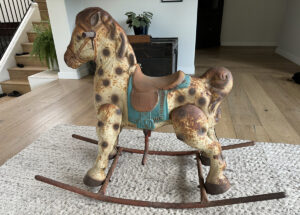 RH sent me a children’s sit-on rocking tin horse that lived in his garage for years. He THINKS it belonged to his mom but he’s not sure. I believe this horse belonged to his mother’s mom or dad. This toy dates from the late 19th or early 20th century.
RH sent me a children’s sit-on rocking tin horse that lived in his garage for years. He THINKS it belonged to his mom but he’s not sure. I believe this horse belonged to his mother’s mom or dad. This toy dates from the late 19th or early 20th century.
Tin toys were stamped and shaped out of thin sheets of tin. Most parents found them hazardous but adorable. I remember a flying saucer made of tin owned by brother Paul in the 1960s. He pumped to make it spin. Eventually the tin seams loosened, and disaster occurred in a little sharp cut to Paul’s hand. Regulations ramped up over the years, but when this horse was made NO regulations existed. The market decided toys sold.
Beloved Horses
The horse figure, a beloved pull-toy and rocker forever, and up till the early 1900s every child became familiar with a real live horse. My grandmother Ruth’s father owned a stable of horses used to pull his ice carts around St Louis. Some of the first horse drawn toys came as horse and wagon combinations with wagons painted to advertise coal, ice, or a fire brigade. The platform horse toys sat on four wheels with a rope. A child delighted to see the rise and fall of the tin horse body attached to one of the axels.
Germany in the late 19th century became an innovative manufacturer of these mechanical wonders, and often attached ringing bells to the platforms. German inventors came up with a horse glider. A ride-on toy coaxed by the rider to lurch back and forth. This carved wooden horse came with real leather tack and a red felt saddle blanket and cantle, and a braided horsehair mane, leather ears, and embossed tin hooves. These, like all horse toys, are highly collectible and fetch $2,000, according to the collector’s site Fabtintoys.
Hand-Painted Horses
One of the best articulated tin hand-painted toys is a pair of golden racehorses in full stride, neck to neck, on a green platform. A rod attached to each of the horses goes through the metal platform, and is attached to an axel, which makes each horse go up and down, similar to a Carrousel horse. A pair of bells in a half circular shape with metal clappers ring as a child pulls the horses. Perfect for a rich little boy wearing his knickers and a cap in 1890.
Another version of the large articulated hand-painted tin horse is the late 19th century clockwork toy horse and rider. A key wound a turned steel coil, which, as it unwinds, initiated forward movement controlled by a cogged balance wheel. These sell for thousands. George W. Brown & Company of Forestville, Connecticut was a leading maker of tinplate clockwork toys circa 1855 to 1880. One of his clockwork eight inch horses sold recently for $1,700. Germany, however, lead the clockwork toy world, creating such toys as a waltzing couple, an acrobat bear, a man and a pushcart, and a clown riding a goat.
Who Made RH’s Rocking Horse?
Dogs also became popular on these platform pull toys, such as a full bodied Spaniel of hand-painted tin. James Fallows and Sons of Philadelphia, maker of painted and stenciled tinplate toys of the late 19th century, may have made RH’s rocking horse. He produced horse-drawn wagons, carts, trains, riverboats, dogs, pairs of horses on platforms, and many different mechanical systems for movement of the horse ON the platforms. He also made goats and horses together, elephants, dog sleds, combat supply trains, trollies, locomotives, and tin tall Christmas candle supports.
Fallows began his business when he decided he could do better than his job as a foreman at the East Coast tin toy company Francis, Field, and Francis. He founded his own business, CB Porter, in 1873. When his sons Henry, Charles, and David joined the business, he changed the name to Frederick and Henry Fallow Toys in 1894. The brand stamped “IXL” means “I Excell,” and the Roman numerals for “61,” supposedly the date Fallows immigrated to the US.
The business faltered with the invention of the chromolithograph, a printing process which negated hand painting. I estimate the value of RH’s rocking horse at $1,200.